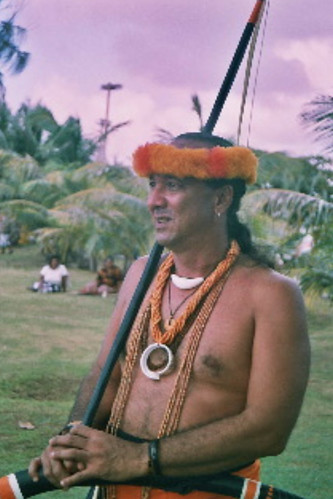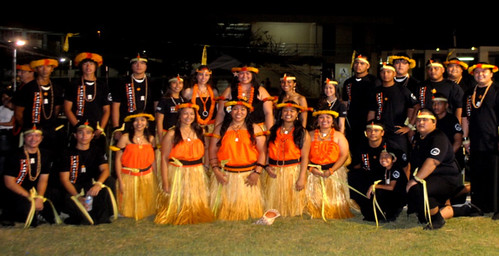Re-Presenting ancient Chamorro culture
Leonard Iriarte (Familian Yåyi) is an educator (fafa’nå’gue) and an oral historian for the I Fanlalai’an Oral History Project.
Iriarte was born on Guam in 1960 and he resides on family land at Sabånan Pali’e’ in northern Guam. In 1970, he began his tutelage in Chamorro song and music composition under the instruction of his father, the late Juan LG Iriarte. That same year his father also formed a family singing group, and some years later they were invited to be a part of the informally-organized Guam delegation to the 1976 Festival of Pacific Arts (FestPac) in New Zealand. The festival afforded Iriarte with the opportunity to observe and familiarize himself with the traditional art forms of the other island nation delegations. The experience led him to puzzle over Guam’s inability to produce and display a traditional Chamorro performance art form. He would ultimately be profoundly affected by the realization that an indigenous performance art form had simply not survived history. It was a deeply felt understanding that made him aware of how much his Chamorro culture had been changed by Western influences.
The experience at FestPac turned Iriarte towards a vigorous study of his own Chamorro culture and history, to the extent that he has become a self-taught researcher, scholar and artist who has taken elaborate steps to re-create ancient Chamorro artifacts. He has not only re-created the art form, but also duplicated the process by which the pieces were made. After careful research into descriptions and drawings by early explorers and from archeological evidence, he replicated and experimented with examples of stone and shell tools that were made by his pre-contact ancestors.
His holistic approach includes a return to the land and the sea to sustain him. He has, on many occasions, caught fish on hooks he made using the designs and materials used by his ancestors. He looks at indigenous methods of land conservation, using organic fertilizers and traditional methods of farming. His respect for the land extends to a spiritual recognition of the presence of his ancestors. According to this respect, he strongly advocates against the taking of artifacts from ancient sites by collectors. His artistic expressions continue to evolve, from re-creations of ancient fishhooks, tools and body adornment; pen and ink drawings of indigenous icons and wood carvings; and to his current interest in the formation of indigenous chants.
In 1998 Iriarte founded the Chamorro chant group, Guma’ Pålu Li’e’ – I Fanlalai’an (The House of the Seeing Mast – The Place For Chant). In 2007, the thriving group highlighted their research efforts under the name I Fanlalai’an Oral History Project, referring to their mission of creating chants as a traditional teaching tool and the preservation of old indigenous words. Iriarte is the principal composer and instructor for this group of about twenty-five students, who compose and practice chants that teach aspects of ancient Chamorro history. His chant compositions use only indigenous Chamorro words and frequently employ allegory and symbolic language. His artistic expressions and sharing of researched information have influenced fellow artists as well as the indigenous community in consciousness-raising and cultural understanding.
Iriarte is a vocal advocate for greater cultural accuracy and authenticity in contemporary expressions of indigenous art and culture, and is guided by traditional values and beliefs. He and his chant group are often called upon to provide indigenous blessings through their chants to open official cultural events. Iriarte stresses that his group activities are for language, historical, and cultural education of their members, and their chants are not for performance purposes.
The goal of each member is the acquisition of an enhanced understanding of the indigenous elements of Chamorro language and culture. The senior members of the group form the research and instruction contingent and lead group discussions about history and linguistic influences. Senior members also strive to enhance their linguistic abilities to be able to compose chants using an exclusively indigenous form of the Chamorro language, called “fino’håya.” They draw their inspiration from historical records, the results of etymological analysis of indigenous word forms and existing practices found in neighboring Micronesian islands that may provide clues to ancient Chamorro ways of life. Their chants are composed of solo and group voices accompanied by body percussion and movement in place. Their chants tell stories of people, activities and events that are inspired by oral and written histories. Their ceremonial attire and body ornamentation are derived from a 17th-century model and utilize the traditional colors produced in ancient times: the orange of the Spondylus shell, black from charcoal and other natural dyes, and white from the åfok (quicklime) and of the hima (Tridacna clam shell) – colors that adorned ancient sailing canoes.
In 2008, Iriarte was recognized as a MARC Manga’chong Associate of the Richard Flores Taitano Micronesian Area Research Center of the University of Guam for his collaboration with the MARC and for his accomplishments in the region toward preservation and creative research and teaching. He has served on several cultural committees and organizations, including the Department of Chamorro Affairs Authentication and Standardization Committee under the directorship of Dr. Katherine Aguon. As a contributing writer and researcher he participated in the production of the book titled, Chamorro Heritage A Sense of Place: Guidelines, Procedures and Recommendations for Authenticating Chamorro Heritage (2003).
Since 1999, Iriarte and his wife have owned and operated Sagan Fina’nå’guen Fino’ Chamorro, a successful daycare facility utilizing a Chamorro early language immersion concept at the core of its mission.
Iriarte and his chant group were part of the official Guam delegation to the Festival of Pacific Arts in Palau in 2004 and in American Samoa in 2008. He and his group were featured in the PBS film, “Dances of Life”, produced by Pacific Islanders in Communication in 2005.
Most recently, on 15 October 2014, Iriarte was given the title of Master of Chamorro Chant by CAHA, an award presented to individuals who practice traditional folk arts and successfully promote Chamorro culture, history or language through the arts on Guam.
Oral histories
Chant
Guma’ Pålu Li’e’ album tracks
Video
For further reading
Guam Council on the Arts and Humanities Agency. “Artists – Guam CAHA.”
I Manfayi: Who’s Who in Chamorro History. VoI. 3. The Hale’-ta Series. Hagåtña: Department of Chamorro Affairs, Division of Research, Publication, and Training, 2002.








